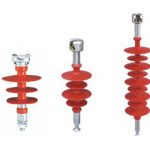-
What is a composite insulator?
The composite insulator is also called the polymeric insulator. It is developed after toughened glass insulator and ceramic insulators, whose main insulation structure is consists of a fiberglass core (rod) and silicon housing and sheds. One both sides, 2 metallic fittings are installed on each side with crimping technics. These 2 metal fittings are for installation and connection on poles, insulators or conductors and cables. They are so well crimped by a crimping machine that sufficient pressure makes it impossible to slip or loose between the metal fittings and fiberglass rod.

-
Where are composite insulators used?
Composite insulators cover a wide range of use in our daily life, on electrical power transmission, distribution, and substations. Railway insulator is also one of the main applications for composite insulators. To mean different demands and purposes of usage of composite insulators, the structure and fittings on both ends are designed into different lengths, space, diameter, and shape.
-
What are the common types of composite insulators?
The common types are:
Suspension composite insulator, mainly used in an electrical transmission line, with a long rod up to more than 3 meters or even 5 meters to isolate steel towers and conductors.
Tension composite insulator, also mainly used in the electrical transmission lines, with a long rod up to more than 3 meters or even 5 meters to isolate steel towers and conductors. They are also seen in distribution lines with lower voltage like 11kv or 33kv, whose tensile function takes the main effect. Some people like to call it a dead-end insulator.
Composite post insulator, or post composite insulator, whatever it’s called, it’s designed for a power substation. These post insulators have a much larger diameter of fiberglass rod, because in substation projects, besides its excellent insulation property, what we need form post insulator is their cantilever load in horizontal directions.
Pin composite insulators, widely used in the power distribution lines, with the voltage of 33kv and 11kv, are used to support conductor and cables, as well as isolate the concrete poles or wooden poles from conductors. The fittings of the pin insulator are different from what’s from a suspension insulator or tension insulator. One side of fittings on the pin insulator is a screw, as the pin insulator shall be installed with bolts and nut on cross-arm of poles (sometimes directly fixed on wooden poles), the other side of fittings usually has a groove to hold the conductor.
-
What type of composite insulator do we produce?
Currently, we contune international corp has been supplying composite suspension insulators, composite tension insulators, composite pin insulators, and composite post insulators from 11kv up to 33kv.
Insulators produced by us have been duly designed to meet the electrical requirement under severe circumstances and their mechanical load has been strictly tested and inspected according to international electrical standard (IEC) to assure their performance and safety.
For suspension insulator and tension insulators, tensile tests are done on them to make sure no accident of slipping or loosing take place after the insulator is loaded with tons of force.
>>See more about “tensile test on insulators”
For polymeric pin insulator and post insulator, cantilever test (bending test) is applied so that bending load can reach and exceed its specific mechanical load. Torsion test is also done on post insulator as this is also one of its most significant functions in the substation environment.
>>See more about “bending and torsion test on insulators”
